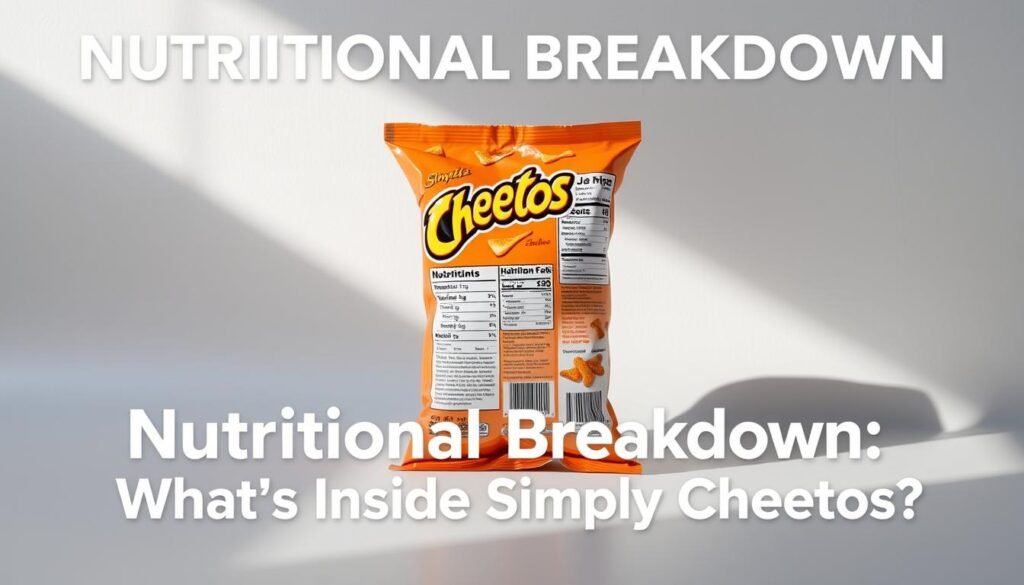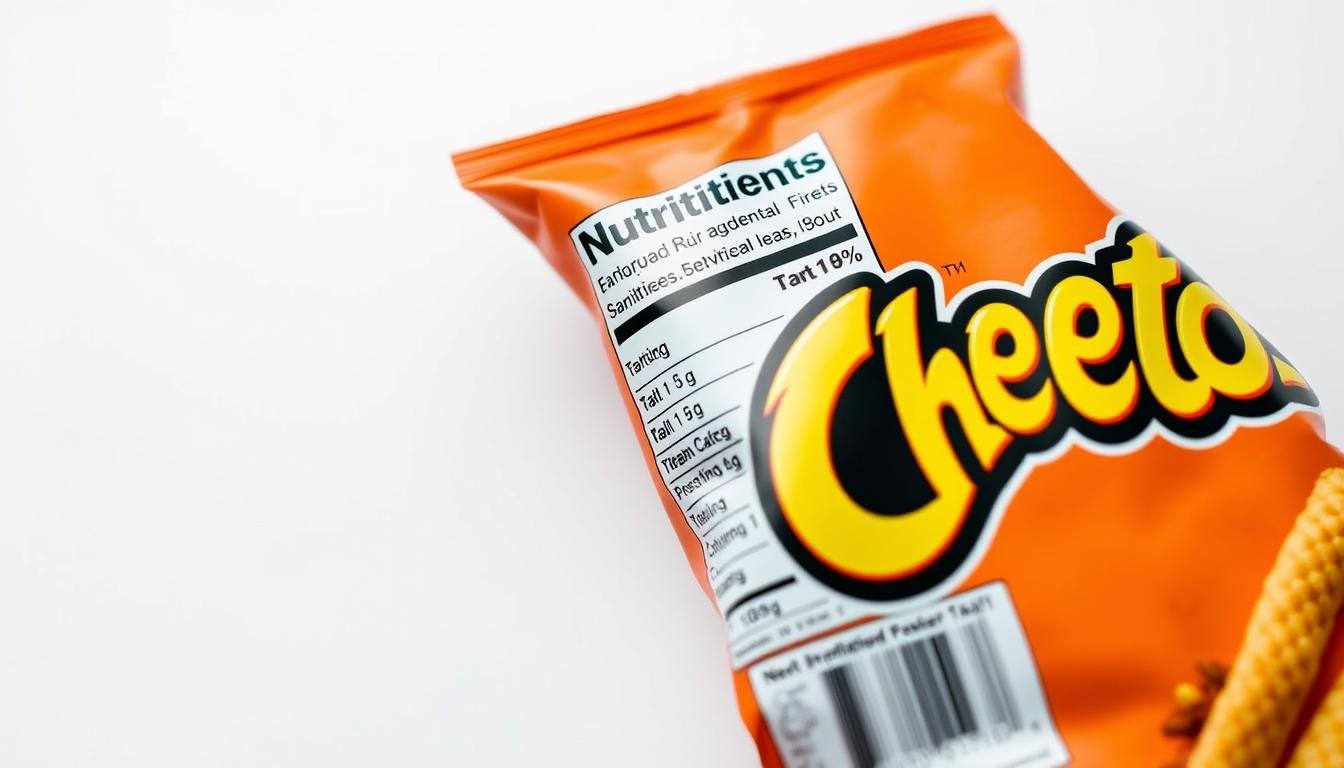Snack lovers often wonder: Can a crunchy, cheesy treat fit into a balanced diet? With growing demand for better-for-you options, Frito-Lay introduced Simply Cheetos as a cleaner-ingredient alternative to the classic snack. But does this version truly offer a nutritious choice?
This product swaps artificial flavors for natural ones, yet still carries 150 calories and 160mg sodium per serving. The Environmental Working Group flags moderate processing concerns for both puffs and crunchy varieties. Even with simpler ingredients, questions remain about long-term health impacts.
We’ll analyze nutrition labels, compare ingredients, and explore whether these snacks deserve space in your pantry. The absence of organic certification might surprise some consumers seeking truly wholesome foods.
Key Takeaways
- Simply Cheetos use cleaner ingredients than original versions
- Each 1oz serving contains 150 calories and 7% daily sodium
- EWG reports show moderate processing concerns
- Product lacks organic certification despite “simpler” formula
- Nutritional value should be weighed against dietary goals
Introduction: Are Simply Cheetos a Smart Snack Choice?
Frito-Lay markets Simply Cheetos as a cleaner option, but does the label tell the full story? While the brand swaps artificial additives for natural flavors, nutritional trade-offs remain. A closer look reveals gaps between marketing claims and dietary reality.
The Environmental Working Group flags three concerning ingredients: natural flavors, enzymes, and riboflavin. Though “natural” sounds harmless, the term lacks strict regulation. This often misleads consumers seeking transparent food choices.
Moderate processing raises another red flag. The classification means the snack undergoes significant alteration from its original form. For weight management, the 150-calorie-per-ounce density adds up quickly.
Dairy ingredients—milk and cheese cultures—may come from antibiotic-treated animals. Combined with 13% daily fat per serving, the snack’s value proposition weakens. With just 2g protein, it offers minimal nutritional benefit.
Before tossing a bag into your cart, scrutinize the label. Healthier snack food choices might better align with long-term wellness goals.
Nutritional Breakdown: What’s Inside Simply Cheetos?
Understanding the nutritional content of snack foods helps make informed choices. Simply Cheetos offer a cleaner ingredient list than traditional versions, but the numbers tell a deeper story. Let’s dissect the label to see how this snack stacks up.

Calories and Serving Size: How Much Are You Really Eating?
A single serving packs 150 calories—about 24 puffs. While this seems manageable, it’s easy to overeat. Compare this to whole foods like apple slices (52 calories) or almonds (160 calories), which provide more nutrients per bite.
Fat Content: Saturated vs. Total Fat
Each serving contains 10g total fat (13% DV), including 1.5g saturated fat. The American Heart Association recommends limiting saturated fats to protect heart health. Though trans fats are absent—a plus—the saturated fat content warrants moderation.
Sodium Levels and Dietary Concerns
With 160mg sodium per serving (7% DV), these snacks add up quickly. Eating multiple servings could push you toward the 2,300mg daily limit. For context, a handful of unsalted nuts has just 1mg sodium.
Protein and Fiber: Are There Any Benefits?
Simply Cheetos deliver minimal protein (2g) and fiber (how Simply Cheetos compare to other.
“Snacks should complement your diet, not compromise it. Balance is key.”
- Calorie density: Higher than whole-food alternatives.
- Fat breakdown: Mostly unsaturated, but saturated fats still present.
- Sodium watch: Multiple servings could exceed healthy limits.
- Nutrient gaps: Low protein and fiber reduce satiety.
Simply Cheetos vs. Traditional Cheetos: Ingredient Showdown
Cleaner labels don’t always mean healthier choices—let’s investigate why. The traditional version contains over 30 ingredients, while the updated formula cuts this down to 20. Both products share similar calorie counts, proving that fewer components don’t automatically equal better nutrition.

Artificial Additives: Colors, Flavors, and Preservatives
Original Cheetos use controversial Yellow 6 dye, flagged by CSPI for potential hyperactivity links. The newer version swaps this for annatto extract, a plant-based coloring. Preservatives also differ significantly—TBHQ gives way to citric acid in the updated product.
Natural flavors appear in both varieties, but the term remains loosely regulated. These complex mixtures often contain dozens of undisclosed chemicals. The Center for Science in the Public Interest warns that such labeling obscures true contents.
Cheese Sources: Real Cheese vs. Artificial Flavoring
While both products contain cheddar, their dairy components differ substantially. The traditional version relies heavily on artificial cheese flavoring. The updated formula incorporates milk and cheese cultures, though these may come from conventionally raised cows.
Lactose-intolerant consumers should note both varieties contain dairy derivatives. The protein content remains low in either case, offering minimal nutritional benefit from the cheese components.
| Ingredient | Traditional | Updated Version |
|---|---|---|
| Corn Base | Enriched cornmeal | Organic cornmeal |
| Cheese Source | Artificial flavoring | Milk and cheese cultures |
| Flavor Enhancers | MSG | None |
Processing Levels: Moderate vs. High Concerns
Food processing significantly impacts nutritional value. The Environmental Working Group classifies the traditional product as highly processed. The updated version earns a moderate rating—better, but still far from whole foods.
Key differences emerge in manufacturing methods:
- Traditional: Multiple extrusion processes alter texture dramatically
- Updated: Simpler production but still involves significant alteration
- Additives: Original contains more synthetic stabilizers
Neither version qualifies as minimally processed. For those prioritizing whole food snacks, both options present dietary compromises. The choice ultimately depends on which trade-offs align with personal health goals.
Potential Health Effects of Regular Consumption
Nutrition experts warn about hidden risks in popular crunchy treats. While occasional enjoyment poses minimal issues, daily consumption could impact multiple body systems. Let’s examine what research reveals about long-term snack food habits.

Weight Management Challenges
At 150 calories per ounce, these snacks add up quickly. NIH studies link processed foods to weight gain due to their low satiety index. The fat-carb combination triggers overeating by delaying fullness signals.
Consider these calorie comparisons:
- 2 servings = 300 calories (15% of 2,000-calorie diet)
- Daily snack habit = 1,050 weekly calories
- Equivalent to 0.3 lbs of potential weight gain weekly
Cardiovascular Considerations
The American Heart Association flags sodium as a key concern. With 160mg per serving, frequent consumption could contribute to hypertension risks. Those watching blood pressure should monitor intake carefully.
| Nutrient | Per Serving | Weekly Impact (7 servings) |
|---|---|---|
| Saturated Fat | 1.5g | 10.5g (53% AHA limit) |
| Sodium | 160mg | 1,120mg (49% daily limit) |
| Calories | 150 | 1,050 |
Hidden Chemical Concerns
The Endocrine Society identifies BPA in packaging as a potential hormone disruptor. While not in the food itself, this chemical can migrate into snacks. Natural flavors may also contain undisclosed compounds affecting sensitive individuals.
Additional health considerations include:
- Dental erosion from starchy residue
- Gut microbiome changes from low fiber
- Potential hyperactivity triggers in children
Moderation remains key when incorporating processed snacks into your diet. For optimal wellness, balance these treats with whole food options rich in nutrients.
The Organic Debate: Are Simply Cheetos Healthier?
Food packaging claims frequently blur the line between marketing and reality. While the Simply line suggests cleaner eating, the absence of USDA organic certification raises questions. This product sits in a gray area between conventional snacks and truly organic options.
Certified Organic Claims (or Lack Thereof)
The Environmental Working Group confirms no organic certification for this product. Despite using some organic corn, the dairy ingredients likely come from conventional farms. Common practices in these operations include:
- Antibiotic use in cattle feed
- GMO feed crops
- Synthetic pesticide application
Compare this to certified organic snacks that must meet strict standards:
| Standard | Certified Organic | Simply Product |
|---|---|---|
| USDA Seal | Required | Absent |
| Pesticides | Prohibited | Allowed |
| Livestock Feed | 100% organic | Conventional |
Natural Flavors vs. Artificial: Is There a Difference?
While the product eliminates artificial colors, “natural flavors” remain vague. The FDA defines natural flavors as substances derived from plant or animal source material. However, these can still undergo significant chemical processing.
“Natural flavoring may contain 50-100 chemicals, just like artificial versions. The difference lies in origin, not necessarily safety.”
Key considerations about flavor ingredients:
- Both types undergo laboratory processing
- Natural versions often cost more without proven health benefits
- Neither provides nutritional value
Environmental and Ethical Considerations
The environmental impact extends beyond packaging waste. Conventional corn farming for snacks contributes to:
- Soil depletion from monocropping
- Water pollution from fertilizer runoff
- High carbon footprint from industrial processing
Ethical concerns include:
- No Fair Trade certification for ingredient sourcing
- Non-GMO Project verification missing
- Potential greenwashing in marketing claims
For truly sustainable snacking, consider alternatives with transparent supply chains and third-party certifications. The choice ultimately depends on your personal health and environmental priorities.
Smart Snacking: Portion Control and Alternatives
Making mindful choices about crunchy treats can satisfy cravings without derailing dietary goals. While processed snacks offer convenience, strategic approaches help balance enjoyment with nutrition.
Mastering Moderation With Packaged Snacks
Pre-portioning snacks into small containers prevents mindless overeating. Try these practical tips:
- Divide large bags into 100-calorie portions immediately after purchase
- Use colorful containers to make controlled servings more appealing
- Pair with fiber-rich vegetables like carrot sticks for better satiety
Timing matters too. Enjoying snacks post-workout helps utilize the energy efficiently. Save sedentary snacking for special occasions.
Nutritious Alternatives Worth Trying
Whole food options deliver crunch without compromise. Consider these satisfying swaps:
| Snack | Benefits | Preparation Time |
|---|---|---|
| Roasted chickpeas | High protein, 5g fiber per serving | 10 minutes |
| Kale chips | Rich in vitamins A, C, and K | 15 minutes |
| Spiced nuts | Healthy fats, magnesium content | 5 minutes |
For cheesy flavor cravings, try this simple recipe:
“Mix nutritional yeast with olive oil and smoked paprika for a dairy-free coating on popcorn or roasted vegetables.”
Rotate different alternatives throughout the week to maintain variety. This prevents snack fatigue while ensuring diverse nutrient intake.
Reading labels becomes easier with practice. Focus first on serving sizes, then scan for added sugars and sodium content. These skills help consumers make informed choices quickly.
Conclusion: Should You Include Simply Cheetos in Your Diet?
Dietary choices impact more than just your taste buds. The product offers cleaner ingredients than traditional versions, yet still carries moderate processing concerns. With 150 calories and 10g fat per serving, it fits best as an occasional treat.
Compare this snack to whole food alternatives for better nutrition. Your overall eating pattern matters more than any single food choice. For those managing weight or blood pressure, portion control becomes essential.
Consider these smart strategies when craving crunchy snacks:
- Pre-portion servings to avoid overeating
- Pair with protein-rich foods for balance
- Choose homemade versions for cleaner ingredients
Consult a nutritionist if you need personalized advice. Remember – informed choices lead to better health outcomes. Download our snack comparison chart for quick reference.




